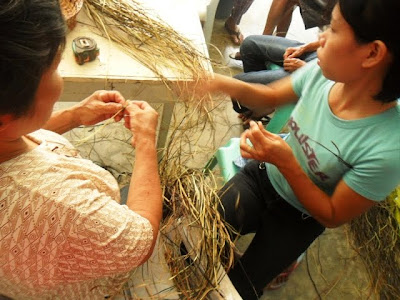 Nito-weaving in Marinduque has traditionally been an additional source of livelihood for some who live in the rural areas. Few, however, have been able to sustain nito-weaving. This is often made possible only with the intervention of a few traders who appreciate the value of the intricate weaving involved in this craft, such as the experience in Gasan. Entrepreneurs see the high value of nito products that only need to be properly marketed, command good prices and make the local artisans inspired to continue producing their products.
Nito-weaving in Marinduque has traditionally been an additional source of livelihood for some who live in the rural areas. Few, however, have been able to sustain nito-weaving. This is often made possible only with the intervention of a few traders who appreciate the value of the intricate weaving involved in this craft, such as the experience in Gasan. Entrepreneurs see the high value of nito products that only need to be properly marketed, command good prices and make the local artisans inspired to continue producing their products.
 The skill of nito weavers in some areas remain with them even after long periods of inactivity. But many farm women who desire to learn this craft, however, also welcome new ideas they could build upon based on the experience of other nito-weavers elsewhere.
The skill of nito weavers in some areas remain with them even after long periods of inactivity. But many farm women who desire to learn this craft, however, also welcome new ideas they could build upon based on the experience of other nito-weavers elsewhere.
In the two hinterland villages of Bocboc and Puting Buhangin in Mogpog, where nito, this fine but strong tropical vine associated with the fern family abundantly grows in the forests, women have expressed interest to revive the craft through an organized program.

A four-day skills training in nito basket ware is currently being held in Brgy. Bocboc under the guidance of Cottage Industry Technology Center (CITC) trainers Rufina Y.Ramos and Ana D. Macapanas of the CITC Pasig office.
The program is part of the livelihood programs being undertaken by the office of Cong. Allan Velasco in cooperation with the Department of Trade and Industry (DTI), and in this instance, upon the initiative of the barangay council of Bocboc led by Brgy. Capt. Fred Muhi.

Mostly married women signed up for this training program. Older nito-weavers from Bocboc village were only too happy to also share their own knowledge and experiences, including problems they’ve encountered, to help strengthen the program. They proudly brought with them samples of products they've made in the past.
The current program also involves the introduction of new tools such as ‘sizers’, shavers and cutting tools, product designs, product costing and marketing strategies. DTI’s Mariden Calub , Harry Gutierrez and Velasco’s staff, Salvador Nerias supervised the program that will end on July 21.


Sizing the nito vine


Intricately woven nito fruit trays
Nito vine (lygodium circinatum). It grows as secondary forest cover clinging to trees and rocks. Its natural beauty and color need no enhancement.










No comments:
Post a Comment